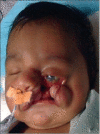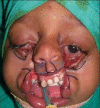Formatting the surgical management of Tessier cleft types 3 and 4
- PMID: 19884673
- PMCID: PMC2825067
- DOI: 10.4103/0970-0358.57192
Formatting the surgical management of Tessier cleft types 3 and 4
Abstract
Tessier cleft types 3 and 4 are rare entities even among what are considered other rare craniofacial clefts. Very few cases have been reported worldwide, especially in the bilateral form. In the absence of any well-laid guidelines for management of such rare cases, plastic surgeons operate on such cases due to the inherent complexities in technique. To overcome this problem and provide a ground rule for surgical management of such cases, we propose an easier format with a 'split approach' of the affected areas. In our proposed formatting, we have divided the affected areas of the cleft into three components: 1. Lid component; 2. Lip component; and 3. Nasomalar component. Any person skilled in the plastic surgical art would appreciate that individual management of the aforesaid demarcated areas is easy as compared to the surgery of the entire craniofacial cleft, that too with the contemporary approach. We have evaluated this formatting technique with a 'split approach' in seven cases and found the results more convincing compared to those of classical methods. We invite the surgical fraternity to validate the surgical formatting in their settings and provide us with feedback on the same to consolidate these results.
Conflict of interest statement
Figures






















References
-
- Joos U, Anastassov E. Treatment of craniofacial midline clefts in association with hamartomas: Report of three cases. J Oral Maxillofac Surg. 1998;56:383–92. - PubMed
-
- Ranta R, Rintala R. Oblique lateral oro-ocular facial cleft. J Oral Maxillofac Surg. 1988;17:186–9. - PubMed
-
- Tessier P. Anatomical classification of facial, cranio-facial and latero-facial clefts. J Maxillofac Surg. 1976;4:69–92. - PubMed
-
- Longaker MT, Lipschutz GS, Kawamoto HK. Reconstruction of Tessier No. 4 Clefts Revisited. Plast Reconstr Surg. 1997;99:1501–7. - PubMed
-
- Accessed from: http://www.odv.bo.it/2002-4//04-tessierIV.rtf.
LinkOut - more resources
Full Text Sources

